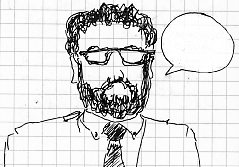Tuesday, December 13, 2005
All's Well That Ends Well
A good ending can really change how you consider a book or movie. In fact, if it's good enough, a fine ending can make you smooth over problems that might have annoyed you as you experienced them in the text or film. It's kind of like instant nostalgia (or magic).
Inspired by Ragnell's list of last lines from comics, here's a description of two extraordinary endings.
(1) Charles Burns' Black Hole, Pantheon, 2005.
(2) William Steig's Abel's Island, Farrar Straus and Giroux, 1976.
This is the first installment to an ongoing list; let me know of books and movies that you think nailed their endings.
Inspired by Ragnell's list of last lines from comics, here's a description of two extraordinary endings.
(1) Charles Burns' Black Hole, Pantheon, 2005.
(Those of you seeking a full review of the text can look here and here. I'm going to provide my impressions of the book's conclusion.) Black Hole's final chapter adroitly ties several important things together, as the author revisits several recurring images, scenes, and lines of dialogue. One young woman tells her lover that "I knew you'd come back," repeating it as a small mantra, and we learn why she particularly needed for this to be true. Chris, the novel's central figure, accepts a painful reality, admitting to herself what the reader knows, that her lover is indeed "gone forever." The book closes with several forceful panels. One is headed by the following thought balloon: "Eliza sitting naked on a pink towel, so beautiful I could die." (This panel is reproduced at the Salon.com review of the book.) Another conveys the novel's final thought: Chris, after all she's been through, finds some peace, and says, "I'd stay out here forever if I could." While the roads facing these characters are by no means straight or clear, their futures have both positive and negative possibilities. (A lesser novelist would have highlighted one over the other.) Burns worked on this book for more than a decade, and I'm glad that he put in those years. Black Hole comes to a wise and mature conclusion, evincing a wisdom and maturity lacking from so many other graphic novels.
(2) William Steig's Abel's Island, Farrar Straus and Giroux, 1976.
Abel (a mouse) is separated from his family, and his recent bride Amanda, by a storm and flood which carries him to an island, where he must learn to survive in the wild. While his previous urban existence has been quite refined and comfortable, Abel now has to secure shelter, defend himself from an owl and a cat, and come to terms with his fear and loneliness. Steig's book isn't a graphic novel, it's actually an illustrated text. However, it ends with four drawn panels; no words are added. The first drawing shows Abel finally at home, having changed into his regular clothes, and lounging on his couch with his legs crossed and his hands behind his head. The next drawing shows his wife arriving at home, and she's overjoyed because she has seen Abel's scarf on a side-table. In the third drawing Amanda drops her bag and calls for her husband. The two end the book in each other's arms, eyes closed, with Amanda's hat having fallen to the ground in her rush to embrace her returned husband. In the remarkable final picture Steig perfectly captures the movement, excited emotion, and the sense of repose and contentment that are a part of the moment.
This is the first installment to an ongoing list; let me know of books and movies that you think nailed their endings.
